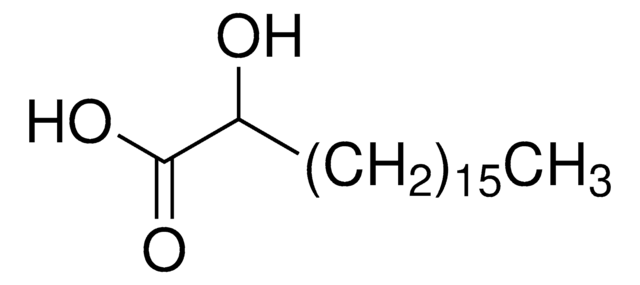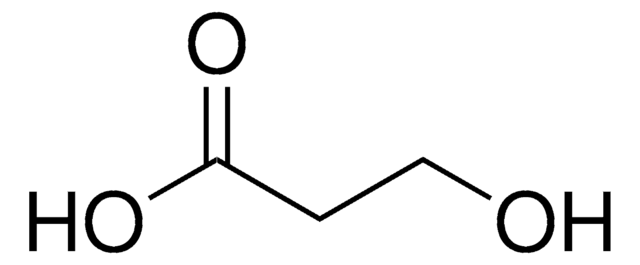H4398
DL-β-Hydroxypalmitic acid
≥98%
Sinônimo(s):
3-Hydroxyhexadecanoic acid
Faça loginpara ver os preços organizacionais e de contrato
About This Item
Fórmula empírica (Notação de Hill):
C16H32O3
Número CAS:
Peso molecular:
272.42
Número MDL:
Código UNSPSC:
12352211
ID de substância PubChem:
NACRES:
NA.25
Produtos recomendados
Nível de qualidade
Ensaio
≥98%
Formulário
powder
grupo funcional
carboxylic acid
tipo de lipídio
saturated FAs
Condições de expedição
ambient
temperatura de armazenamento
2-8°C
cadeia de caracteres SMILES
CCCCCCCCCCCCCC(O)CC(O)=O
InChI
1S/C16H32O3/c1-2-3-4-5-6-7-8-9-10-11-12-13-15(17)14-16(18)19/h15,17H,2-14H2,1H3,(H,18,19)
chave InChI
CBWALJHXHCJYTE-UHFFFAOYSA-N
Ações bioquímicas/fisiológicas
DL-β-Hydroxypalmitic acid is a mixture of D- and L-β-hydroxypalmitic (3-hydroxyhexadecanoic) acids. 3-hydroxyhexadecanoic [C16:0(3-OH)] may be used in studies that involve the lipid structures of endotoxin lipid A molecules.
Código de classe de armazenamento
11 - Combustible Solids
Classe de risco de água (WGK)
WGK 3
Ponto de fulgor (°F)
Not applicable
Ponto de fulgor (°C)
Not applicable
Equipamento de proteção individual
Eyeshields, Gloves, type N95 (US)
Escolha uma das versões mais recentes:
Já possui este produto?
Encontre a documentação dos produtos que você adquiriu recentemente na biblioteca de documentos.
Os clientes também visualizaram
R P Garg et al.
Molecular microbiology, 38(2), 359-367 (2000-11-09)
In the phytopathogen Ralstonia (Pseudomonas) solanacearum, control of many virulence genes is partly mediated by the Phc cell density sensing system. Phc uses a novel self-produced signal molecule [3-hydroxypalmitic acid methyl ester (3-OH PAME)], an atypical two-component system (PhcS/PhcR), and
P Vadovic et al.
Acta virologica, 51(4), 249-259 (2008-01-17)
The composition and structure of lipid A isolated from the lipopolysaccharide (LPS) of Piscirickettsia salmonis were investigated by chemical analyses, gas chromatography/mass spectrometry (GCMS), and electrospray ionization (ESI) combined with the tandem mass spectrometry (MS/MS). Our study revealed moderate compositional
A Fjellbirkeland et al.
Archives of microbiology, 168(2), 128-135 (1997-08-01)
Membranes obtained from whole-cell lysates of Methylococcus capsulatus (Bath) were separated by Triton X-100 extraction. The resulting insoluble fraction was enriched in outer membranes as assessed by electron microscopy and by the content of beta-hydroxy palmitic acid and particulate methane
Paul J Brett et al.
Molecular microbiology, 63(2), 379-390 (2006-12-14)
Burkholderia mallei, the aetiologic agent of glanders, causes a variety of illnesses in animals and humans ranging from occult infections to acute fulminating septicaemias. To better understand the role of lipopolysaccharide (LPS) in the pathogenesis of these diseases, studies were
M Shinohara et al.
Journal of applied microbiology, 103(1), 152-162 (2007-06-23)
To screen novel micro-organisms and enzymes capable of degrading 3-hydroxypalmitic acid methyl ester (3-OH PAME), the quorum-sensing signal molecule (quormone), which regulates the virulence of Ralstonia solanacearum. Ideonella sp. 0-0013, a betaproteobacterium isolated from soil using the selective-enrichment culture method
Nossa equipe de cientistas tem experiência em todas as áreas de pesquisa, incluindo Life Sciences, ciência de materiais, síntese química, cromatografia, química analítica e muitas outras.
Entre em contato com a assistência técnica















